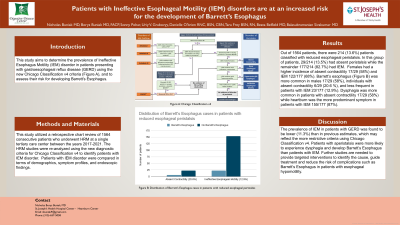Tuesday Poster Session
Category: Esophagus
P3230 - Patients with Ineffective Esophageal Motility (IEM) Disorder Are at an Increased Risk for the Development of Barrett’s Esophagus
Tuesday, October 24, 2023
10:30 AM - 4:00 PM PT
Location: Exhibit Hall

Has Audio

Nicholas B. Buniak, MD
St. Joseph's Hospital Health Center - Heartburn Center
Syracuse, NY
Presenting Author(s)
Nicholas Buniak, MD, Borys Buniak, MD, Sonny Pohar, BS, Uriy Grabovyy, , Danielle Obrien, RNC, BSN, CBN, Tara Frey, BSN, RN, Beata Belfield, MD, Balasubramian Sivakumar, MD
St. Joseph's Hospital Health Center - Heartburn Center, Syracuse, NY
Introduction: This study aims to determine the prevalence of Ineffective Esophagus Motility (IEM) disorder in patients presenting with gastroesophageal reflux disease (GERD) using the new Chicago Classification v4 criteria, and to assess their risk for developing Barrett’s Esophagus.
Methods: This study utilized a retrospective chart review of 1564 consecutive patients who underwent HRM at a single tertiary care center between the years 2017-2021. The HRM studies were re-analyzed using the new diagnostic criteria for Chicago Classification v4 to identify patients with IEM disorder. Patients with IEM disorder were compared in terms of demographics, symptom profiles, and endoscopic findings.
Results: Out of 1564 patients, there were 214 (13.6%) patients classified with reduced esophageal peristalsis. In this group of patients, 29/214 (13.5%) had absent peristalsis while the remainder 177/214 (82.7%) had IEM. Females had a higher incidence of aperistalsis 17/29 (58%) and IEM 122/177 (68%). Barrett’s esophagus was more common in males 17/29 (58%), individuals with aperistalsis 6/29 (20.6 %) and less frequent in patients with IEM 23/177 (12.9%). Dysphagia was more common in patients with aperistalsis 17/29 (58%) while heartburn was the more predominant symptom in patients with IEM 155/177 (87%).
Discussion: The prevalence of IEM in patients with GERD was found to be lower (11.3%) than in previous estimates, which may reflect the more restrictive criteria using Chicago Classification v4. Patients with aperistalsis were more likely to experience dysphagia and develop Barrett’s Esophagus than patients with IEM. Further studies are needed to provide targeted interventions to identify the cause, guide treatment and reduce the risk of complications such as Barrett’s Esophagus in patients with esophageal hypomotility.
Disclosures:
Nicholas Buniak, MD, Borys Buniak, MD, Sonny Pohar, BS, Uriy Grabovyy, , Danielle Obrien, RNC, BSN, CBN, Tara Frey, BSN, RN, Beata Belfield, MD, Balasubramian Sivakumar, MD. P3230 - Patients with Ineffective Esophageal Motility (IEM) Disorder Are at an Increased Risk for the Development of Barrett’s Esophagus, ACG 2023 Annual Scientific Meeting Abstracts. Vancouver, BC, Canada: American College of Gastroenterology.
St. Joseph's Hospital Health Center - Heartburn Center, Syracuse, NY
Introduction: This study aims to determine the prevalence of Ineffective Esophagus Motility (IEM) disorder in patients presenting with gastroesophageal reflux disease (GERD) using the new Chicago Classification v4 criteria, and to assess their risk for developing Barrett’s Esophagus.
Methods: This study utilized a retrospective chart review of 1564 consecutive patients who underwent HRM at a single tertiary care center between the years 2017-2021. The HRM studies were re-analyzed using the new diagnostic criteria for Chicago Classification v4 to identify patients with IEM disorder. Patients with IEM disorder were compared in terms of demographics, symptom profiles, and endoscopic findings.
Results: Out of 1564 patients, there were 214 (13.6%) patients classified with reduced esophageal peristalsis. In this group of patients, 29/214 (13.5%) had absent peristalsis while the remainder 177/214 (82.7%) had IEM. Females had a higher incidence of aperistalsis 17/29 (58%) and IEM 122/177 (68%). Barrett’s esophagus was more common in males 17/29 (58%), individuals with aperistalsis 6/29 (20.6 %) and less frequent in patients with IEM 23/177 (12.9%). Dysphagia was more common in patients with aperistalsis 17/29 (58%) while heartburn was the more predominant symptom in patients with IEM 155/177 (87%).
Discussion: The prevalence of IEM in patients with GERD was found to be lower (11.3%) than in previous estimates, which may reflect the more restrictive criteria using Chicago Classification v4. Patients with aperistalsis were more likely to experience dysphagia and develop Barrett’s Esophagus than patients with IEM. Further studies are needed to provide targeted interventions to identify the cause, guide treatment and reduce the risk of complications such as Barrett’s Esophagus in patients with esophageal hypomotility.
Disclosures:
Nicholas Buniak indicated no relevant financial relationships.
Borys Buniak indicated no relevant financial relationships.
Sonny Pohar indicated no relevant financial relationships.
Uriy Grabovyy indicated no relevant financial relationships.
Danielle Obrien indicated no relevant financial relationships.
Tara Frey indicated no relevant financial relationships.
Beata Belfield indicated no relevant financial relationships.
Balasubramian Sivakumar indicated no relevant financial relationships.
Nicholas Buniak, MD, Borys Buniak, MD, Sonny Pohar, BS, Uriy Grabovyy, , Danielle Obrien, RNC, BSN, CBN, Tara Frey, BSN, RN, Beata Belfield, MD, Balasubramian Sivakumar, MD. P3230 - Patients with Ineffective Esophageal Motility (IEM) Disorder Are at an Increased Risk for the Development of Barrett’s Esophagus, ACG 2023 Annual Scientific Meeting Abstracts. Vancouver, BC, Canada: American College of Gastroenterology.
